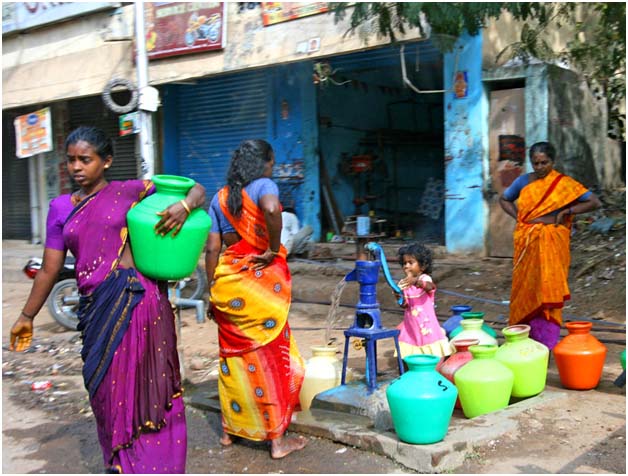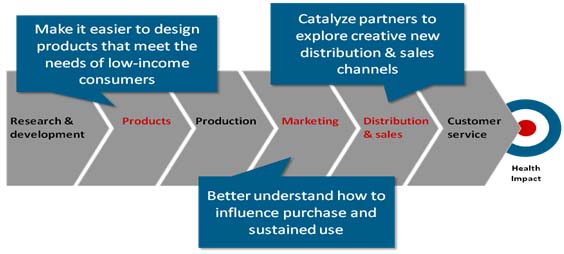Guest post: Amita Bhaduri
Through the Safe Water Project, it is seeking complementary solutions to sustainability and scale-up by exploring the potential for commercial enterprises to produce, distribute, sell, and maintain Household Water Treatment and Storage (HWTS) consumer products to low-income populations. The workshop shared learnings and tools from PATH’s Safe Water Project and presented the experiences of other organizations that are leveraging market-based approaches to achieve a sustainable public health impact.

To increase access to clean water among low-income households in the developing world, PATH has been working to identify, adapt, and develop appropriate products and business models for HWTS devices. The goal is to build a sustainable commercial market for HWTS products in developing nations.
The objectives of the workshop were -
- Expansion of market for household water treatment and storage (HWTS) products for low income populations in India: The Safe Water Project is seeking to catalyze the HWTS space for provision of products and services to low income markets in developing countries to address the disease burden of diarrhoeal diseases. The pilot, product design and research activities conducted in the project have helped PATH collect evidence and learning about the dynamics of this proposition. PATH seeks to disseminate the results and share tools and approaches developed during the project.
- Introduce promising technology and user research for appropriate products: There are a wide variety of HWTS products available in developing markets but many are not available for use by the most vulnerable populations due to lack of access, affordability as well as behavioral constraints. PATH has developed HWTS products and technologies which are appropriate for adoption and use by vulnerable populations at the bottom of the pyramid in developing countries and has also conducted extensive user testing to understand and translate consumer behaviors around HWTS products. PATH seeks to disseminate these developments to key stakeholders in the HWTS manufacturing and distribution space in India to catalyze availability of such products to vulnerable populations which the current industry is not able to reach.
- Catalyzing use of alternative commercially sustainable distribution channels for products targeting low income populations for a public health impact: Safe Water Project has had immense learning from the various distribution models piloted during the project that can be used to influence new and at-scale implementation of a wide variety of public health products and services for commercially sustainable provision.
- Way forward for reducing the incidence of diarrhoeal diseases through an inclusive commercial sector approach: Safe Water Project has focused on HWTS products, tools, and approaches that can be effective in providing HWTS products to low income populations in resource poor settings. However, HWTS products touch on only a part of the preventive side of the larger WASH (water, sanitation and hygiene) landscape. To address diarrhoeal diseases effectively, the entire spectrum of challenges and prevention and treatment solutions need to be considered. PATH plans to disseminate the takeaways from Safe Water Project covering commercial sector approaches to international donors and multilateral agencies to catalyze discussion about addressing the spectrum of WASH issues through these approaches and incorporating the learnings from the Safe Water Project in future programmatic activities.
The workshop included participation from commercial HWTS providers, research organizations, industry bodies, NGOs, and public sector entities working in water and sanitation. The following topics were covered in the workshop -
- Market based solutions to increase access to WASH and other health-care products and services at the bottom of the pyramid.
- Appropriate products for household and community water treatment
- Micro-finance as a vehicle for delivery of WASH services and products.
- Way forward for reducing the incidence of diarrhoeal diseases through a commercial sector approach.
The keynote address delivered by Mr. Gourishankar Ghosh, Ex Mission Director, RGNDWM dealt with the need for HWTS system and how WASH is critical to sustainable development. The wide range of activities and work being done in the area by organizations such as WaterAid, UNICEF etc., with communities, governments and like-minded organizations was discussed.
The presentation by Glen Austin, PATH on “Market based approaches to WASH” began with an account of water, sanitation and hygiene needs and thereafter provided an overview of PATH’s WASH related work. He dealt with the extent to which market-based approaches help accelerate widespread adoption and sustained use of household water treatment and safe storage (HWTS) products by low-income populations over time.
Working with the private sector is a core part of PATH’s DNA and in many ways, the Safe Water Project approach is similar to PPPs PATH has developed over the past 30 years. However the Safe Water Project is different in one key regard. In most of PATH’s public-private partnerships, PATH anticipates aggregated public sector demand and purchase as is the case for example with vaccines purchased by UNICEF. However the Safe Water Project anticipates purchase decisions at the household level – not at the aggregated public sector demand level. This is viewed as an expansion of PATH’s strategy, not a wholesale change. But PATH understands that increased emphasis on the private sector yields benefits but also some challenges. For example, market based solutions cannot be expected to reach the poorest of the poor. PATH’s goal is to find a sweet spot that allows the private sector to earn a profit, unlock the benefits of a market based solution (innovation, responsive efficiency), and reach as far into the Base of Pyramid (BoP) as possible.

Addressing the gaps in HWTS provision
The value chain gap analysis is a framework PATH has used to focus its efforts to increase access of HWTS products. Its efforts to date have focused on three main gaps which currently inhibit scale across low income populations: (a) the lack of affordable and effective products designed for low income users (b) the low-priority of water treatment and (c) and finally, the lack of distribution models that reach low income populations.
The results from PATH’s Safe Water Project pilots were also discussed in terms of six key questions regarding impact, sustainability, and scale.
- What is the uptake rate among target consumers of HWTS products?
- What is the extent of consistent and correct use?
- What are the triggers and barriers to trial and use?
- Can profit be earned from sales to target consumers?
- Will partners continue and/or scale up the SWP model?
- What other efforts/inputs/incentives are needed to stimulate additional supply and demand for HWTS?
The conclusions on the potential for market-based solutions in the HWTS provision are –
- If it works, it scales: The micro-finance model has most potential for success and is currently being scaled without donor support.
- There is a role for market-based solutions in reaching further down the income pyramid. NGOs and the public sector can add value, catalyze innovation, provide incentives and reduce risk and conduct real-time monitoring for improved results.
The presentation by Tanya Dargan and Tim Elliott of PATH on “Experiences from the safe water project: Micro-finance for WASH delivery” dealt with Micro Finance Institutions (MFIs) as a distribution channel. The problem which manufacturers face is of lack of supply of HWTS products due to high distribution costs for which they can leverage existing MFI reach. The low demand for HWTS products due to lack of affordability can be addressed by customizing MF loan for HWTS product and generating awareness through aggregated MFI platform.
The presentation by Dr. K Chandrasekhar dealt with the work of the Water Quality Association (WQA), a not-for-profit international trade association representing the residential, commercial and industrial water treatment industry. WQA maintains a close dialogue with other organizations representing different aspects of the water industry in order to best serve consumers, government officials, and industry members in the USA but in India its focus is on end users.
Pat Lennon in his presentation on new HWTS product development dealt with the design iterations which involved testing with final extended user testing visit. He also stated that going too far from existing devices causes confusion. Ashish Karamchandani, Monitor Inclusive Markets in his presentation dealt with leveraging MFIs for non financial products. MFIs according to him had scale, right reach, right attitude and some capabilities. He also explained the seven key modes in which MFIs can leverage their distribution and credit networks, some of which can be used in combination with each other. Focus groups with MFI customers and broader consumer research showed that customers are willing to buy non-loan products from MFIs.
Deepak Saksena of Hindustan Unilever Limited in his presentation dealt with how micro-finance can be used as a route to climb to the base of the pyramid. Elaine Marie Ghosh of Parinaam Foundation dealt with the organization's experiences related to scaling up of the safe water devices across India, in this instance “Pureit device” developed by HUL.
During the panel discussion Urvashi Prasad of Michael and Susan Dell Foundation dealt with the Foundation’s experience as regards market based solutions for providing water and sanitation services to the urban poor. Ram Ganeshan of ABT Associates discussed how identifying revenue streams/pricing structure needed a basket of goods approach if one wants to sell goods in rural areas. Vinod Kothari of SRTT dealt with the Trust’s work on inclusiveness through integration of market based solutions in health care delivery with a special reference to WATSAN. Amir U Khan, Bill and Melinda Gates Foundation discussed how their focus has been on technology and on working with partners to expand affordable access to sanitation.
These presentations were followed by working group sessions on the second day which addressed the following questions –
- How can targeted subsidies complement commercial investments for setting up an MFI distribution channel?
- How can we vary the MFI distribution model to reach the most vulnerable?
- What role does supplier financing and livelihood generation play in the MFI model for household and community-based water treatment solutions?
- What does the regulatory shake-up mean for the MFI based distribution model for health-care delivery in terms of group structures, profitability etc.?
PATH is an international, nonprofit organization that creates sustainable, culturally relevant solutions, enabling communities worldwide to break longstanding cycles of poor health. By collaborating with diverse public- and private-sector partners, PATH helps provide appropriate health technologies and vital strategies that change the way people think and act. PATH’s work improves global health and well-being.
Please find below the links to the project briefs which can be downloaded from the PATH website –
- PATH’s Safe water project
- Commercial approaches to providing safe water in India: A literature review
- Bicycle entrepreneur distribution model in Uttar Pradesh
- Micro-financing pilot in India
- Extended user testing of water treatment devices in Andhra Pradesh
- Development of the Safe water project reference design and design guidelines
- Low-cost solution to safe water for small communities
- Other Safe water project briefs
Download the presentations below :
/articles/safe-water-dissemination-workshop-path-held-january-19-20-2012-new-delhi